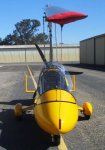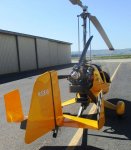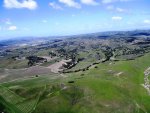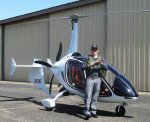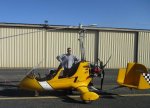- Joined
- Oct 30, 2003
- Messages
- 18,374
- Location
- Santa Maria, California
- Aircraft
- Givens Predator
- Total Flight Time
- 2600+ in rotorcraft
Training a new flight instructor is a great responsibility because this flight instructor will be teaching people to fly for many years. It is also a high honor. I approach training a new flight instructor as a high honor for a flight instructor.
I have flown with thirty seven flight instructors and I learned something from each of them.
They were not all good.
November of 2017 Peter was a client seeking a Sport Pilot, Gyroplane add on rating to his private pilot certificate and after he passed his proficiency check ride he built an American Ranger in Florida and flew it back to California getting his Private Pilot, Rotorcraft-Gyroplane rating in Texas along the way.
Now I am working with him to become a Flight instructor for Sport Pilot, Gyroplane.
In his confidence; Peter has already scheduled his check ride for the middle of March.
I don’t want to screw up my 100% pass rate or compromised safety so I am very cautious.
Peter has passed the knowledge tests and just needs to do his oral examination and check ride.
To be a flight instructor you need to be able to demonstrate maneuvers to practical test standards from either seat while explaining them to the client. You also need to brief the mission accurately and debrief constructively. Everything needs to be to FAA standards and phraseology.
I had Peter print up a sheet of all the maneuvers we needed to cover as our time would be limited.
Peter flew up here from Whitman 2/19 (about 110 miles to the south east) to Santa Maria. Morning fog delayed his departure so he didn’t get here till 11:00.
I explained I would be wearing three hats; A by the book examiner (either you meet the standards or you don’t), a recalcitrant student working on his Sport Pilot, Gyroplane certificate and a flight instructor trying to help Peter meet the standards. These are three distinctly different personalities.
We did our weight and balance and discovered we would only be able to carry ten gallons of gas.
After a preflight inspection we got ready to fly and we discovered that Peter’s microphone didn’t work well in the back seat. Peter has been in the USA for more than twenty years and still has a very strong Bulgarian accent and I often have trouble understanding him and the garbled microphone made it much worse. We did a radio check and ground came back with four by five also known as plenty of power but difficult to understand.
Peter normally flies his American Ranger from the front seat so he was not aware of the problem. I could hear the tower well; I just couldn’t understand Peter and Peter could hear me. The plugs were not the same as mine so we could not use my helmets.
We quickly came up with a plan B. I would be the examiner and the flight instructor trying to help him reach the practical test standards and have him teach me to fly another time.
His air work on several maneuvers was not to practical test standards in part due to his inexperience flying from the back seat and in part his instruments in the back seat were difficult to read and required real focus to interpret.
I leaned hard left and Peter could see over my shoulder and that helped.
I reminded Peter of the basics, power for altitude and pitch for speed. In the real world I use my speed to control altitude on long cross country flights but the maneuvers needed to be done to practical test standards and the easiest way to achieve that is power for altitude and pitch for speed.
On 2/20 Peter took some time to adjust the intercom and managed to make it worse. The tower could barely understand Peter and it did not help me at all and now I could not understand the tower either.
We had what Peter described as “The Flight from Hell!” and did our slow flight maneuvers with great difficulty communicating coming up to practical test standards.
On the way back he asked me to make the radio calls and I could not understand him so we worked through it annoying the tower in the process.
We finished up around 2:00 with plans for a second instructional session where he teaches me to fly.
I felt Peter needs to practice more from the back seat and he has a friend closer to Whitman that is going to help him with that.
Being able to understand him on the intercom is an important piece of the puzzle.
I feel it was twelve hours well spent and look forward to our next flight instructor lesson.
54, 55 and 56. The American Ranger that Peter built.
58. Peter flying from the back seat of his American Ranger.
63. One of my practice areas.
1. Peter taking a picture of me taking a picture of him.
I have flown with thirty seven flight instructors and I learned something from each of them.
They were not all good.
November of 2017 Peter was a client seeking a Sport Pilot, Gyroplane add on rating to his private pilot certificate and after he passed his proficiency check ride he built an American Ranger in Florida and flew it back to California getting his Private Pilot, Rotorcraft-Gyroplane rating in Texas along the way.
Now I am working with him to become a Flight instructor for Sport Pilot, Gyroplane.
In his confidence; Peter has already scheduled his check ride for the middle of March.
I don’t want to screw up my 100% pass rate or compromised safety so I am very cautious.
Peter has passed the knowledge tests and just needs to do his oral examination and check ride.
To be a flight instructor you need to be able to demonstrate maneuvers to practical test standards from either seat while explaining them to the client. You also need to brief the mission accurately and debrief constructively. Everything needs to be to FAA standards and phraseology.
I had Peter print up a sheet of all the maneuvers we needed to cover as our time would be limited.
Peter flew up here from Whitman 2/19 (about 110 miles to the south east) to Santa Maria. Morning fog delayed his departure so he didn’t get here till 11:00.
I explained I would be wearing three hats; A by the book examiner (either you meet the standards or you don’t), a recalcitrant student working on his Sport Pilot, Gyroplane certificate and a flight instructor trying to help Peter meet the standards. These are three distinctly different personalities.
We did our weight and balance and discovered we would only be able to carry ten gallons of gas.
After a preflight inspection we got ready to fly and we discovered that Peter’s microphone didn’t work well in the back seat. Peter has been in the USA for more than twenty years and still has a very strong Bulgarian accent and I often have trouble understanding him and the garbled microphone made it much worse. We did a radio check and ground came back with four by five also known as plenty of power but difficult to understand.
Peter normally flies his American Ranger from the front seat so he was not aware of the problem. I could hear the tower well; I just couldn’t understand Peter and Peter could hear me. The plugs were not the same as mine so we could not use my helmets.
We quickly came up with a plan B. I would be the examiner and the flight instructor trying to help him reach the practical test standards and have him teach me to fly another time.
His air work on several maneuvers was not to practical test standards in part due to his inexperience flying from the back seat and in part his instruments in the back seat were difficult to read and required real focus to interpret.
I leaned hard left and Peter could see over my shoulder and that helped.
I reminded Peter of the basics, power for altitude and pitch for speed. In the real world I use my speed to control altitude on long cross country flights but the maneuvers needed to be done to practical test standards and the easiest way to achieve that is power for altitude and pitch for speed.
On 2/20 Peter took some time to adjust the intercom and managed to make it worse. The tower could barely understand Peter and it did not help me at all and now I could not understand the tower either.
We had what Peter described as “The Flight from Hell!” and did our slow flight maneuvers with great difficulty communicating coming up to practical test standards.
On the way back he asked me to make the radio calls and I could not understand him so we worked through it annoying the tower in the process.
We finished up around 2:00 with plans for a second instructional session where he teaches me to fly.
I felt Peter needs to practice more from the back seat and he has a friend closer to Whitman that is going to help him with that.
Being able to understand him on the intercom is an important piece of the puzzle.
I feel it was twelve hours well spent and look forward to our next flight instructor lesson.
54, 55 and 56. The American Ranger that Peter built.
58. Peter flying from the back seat of his American Ranger.
63. One of my practice areas.
1. Peter taking a picture of me taking a picture of him.


